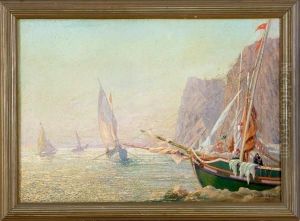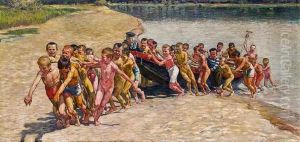Nikolay Belski Bogdanoff Paintings
Nikolay Petrovich Bogdanov-Belsky was a significant Russian painter born on December 8, 1868, in the village of Shitiki in Smolensk Governorate of the Russian Empire (present-day Russia). Coming from a peasant family, Bogdanov-Belsky's artistic path was a testament to his talent and determination overcoming the constraints of his humble beginnings. His early life on the countryside and the people he met there would later influence the subjects of his paintings, often focusing on peasant life, children, and education, imbued with a sense of idealism and beauty.
Educated initially at the Semyon Rachinsky’s school, a place known for its progressive educational methods and attention to the arts and culture, Bogdanov-Belsky's talent was apparent from an early age. In 1882, he moved to St. Petersburg to study art, supported by a scholarship. He attended the Imperial Academy of Arts, where he studied under the guidance of prominent artists like Ilya Repin and Arkhip Kuindzhi, honing his skills in portrait painting and landscapes. His education was further enriched by travels to Europe, where he studied the works of Western European masters, broadening his artistic vision.
Bogdanov-Belsky's work gained recognition for its realistic portrayal of Russian rural life, showcasing his deep connection to his roots and empathy for the peasants' way of life. He was particularly celebrated for his paintings of children and scenes of rural education, reflecting his belief in the power of education and learning. His most famous works, such as 'Spell-bound by the sunset' and 'Mental Arithmetic. In Public School of S. Rachinsky.', showcase his ability to blend realism with the softness of impressionist influences, creating evocative scenes that are both poignant and serene.
In 1894, Bogdanov-Belsky became a member of the Peredvizhniki (Wanderers), a cooperative of Russian realist artists who sought to portray the Russian landscape and the lives of its people with sincerity and a social consciousness. His association with this group further solidified his reputation as a significant figure in Russian art.
Following the Russian Revolution, the changing political and social landscape prompted Bogdanov-Belsky to move to Latvia in 1921, where he continued to work and exhibit his art. Despite the challenges of relocation and the changing art scene, his work remained popular, and he continued to exhibit internationally, including shows in the United States.
Nikolay Petrovich Bogdanov-Belsky passed away on February 19, 1945, in Berlin, Germany. His legacy is preserved in the numerous paintings that capture the essence of Russian rural life and the beauty of its landscapes and people. Today, his works are held in high regard and can be found in museums and private collections around the world, celebrated for their contribution to the Russian realist and impressionist traditions.

